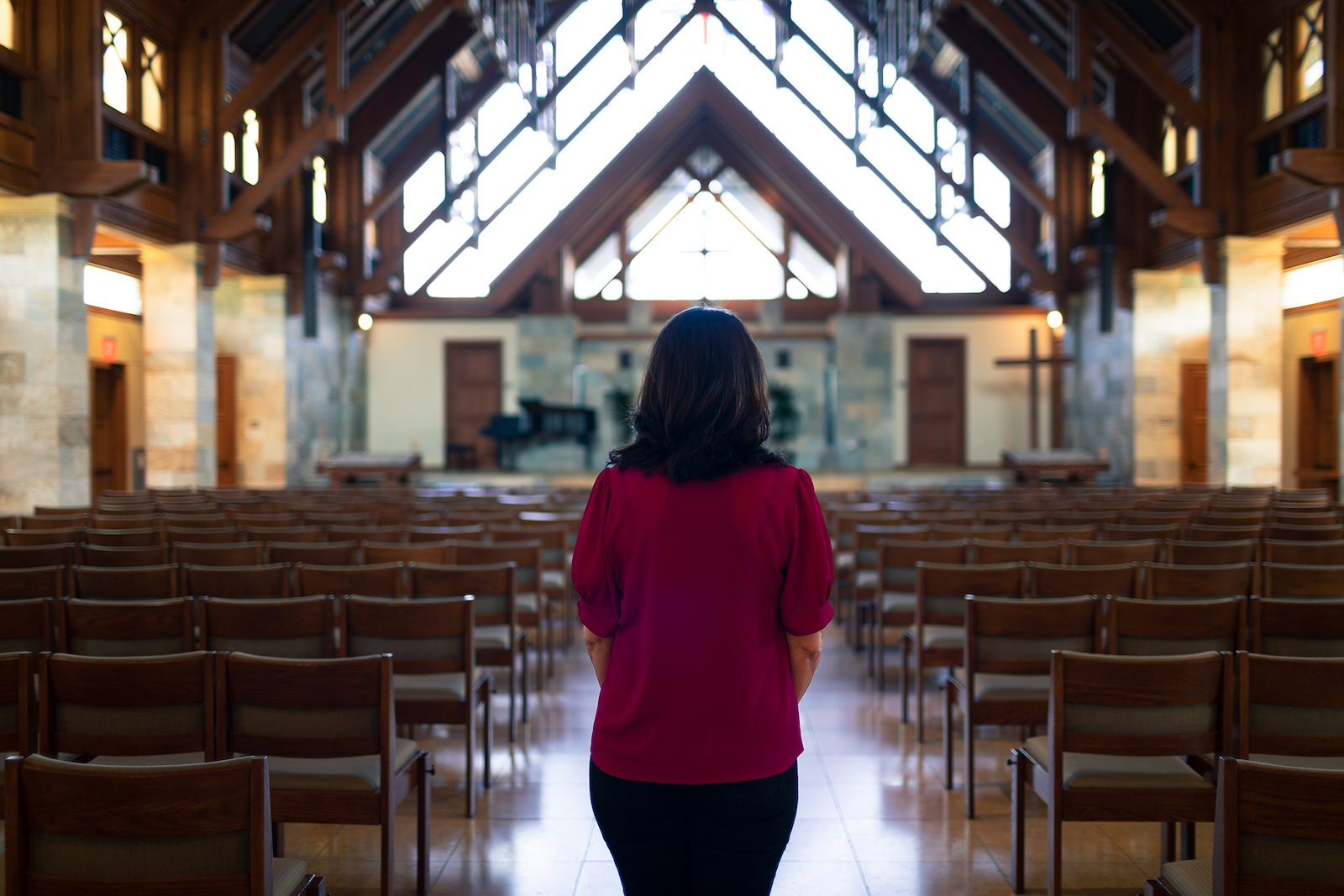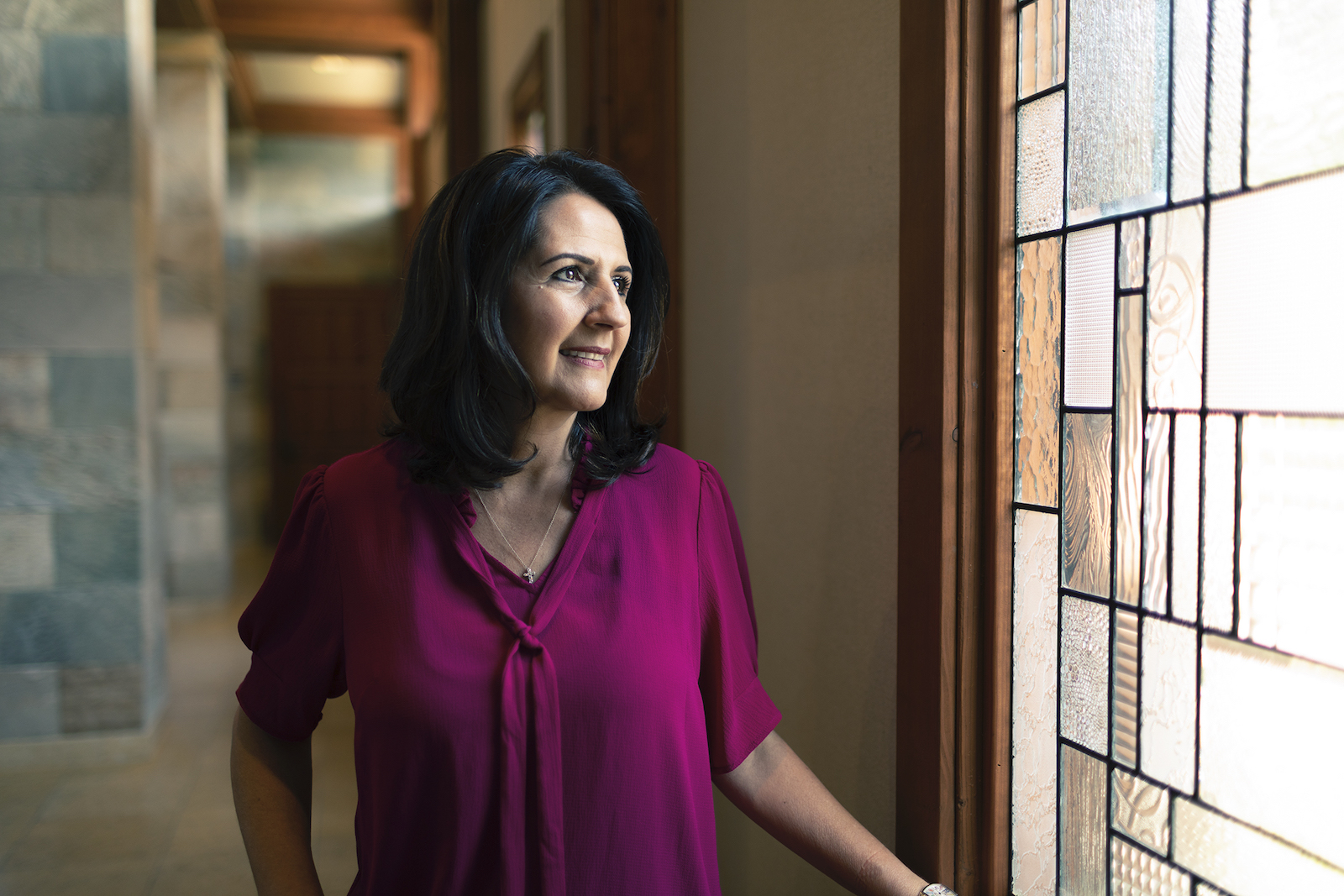
Ines Socorro Franklin (MDiv ’14) was the sixth of seven children in her family, growing up in poverty in Puerto Rico. “My abuelita, my grandmother, wanted me to be a nun,” she says. At seven years old, she attended her first catechism class and promptly got on the bad side of the nun in charge, who was teaching the children that God created everything, that nothing existed before God created it. Ines’s young mind was spinning. “I had this picture of blackness, and God floating.” She raised her hand to ask her burning question: “Where was God standing before everything was created?” The nun scolded Ines for her lack of faith and sent her to the back pew of the old church to recite the Hail Mary and Our Father prayers until the class was over.
Ines Socorro was named by her abuelita. Ines—after Saint Ines, also known as Saint Agnes of Rome, who was canonized as a martyr by the Roman Catholic Church. Her middle name, Socorro, means “help” in Spanish, and is taken from a name given to the Virgin Mary, Maria del Perpetuo Socorro, or “Mary of Perpetual Succour.” Contrary to her abuelita’s wishes, Ines didn’t want to be a nun. She and her family moved to California when she was 16, and her Catholic grandmother stayed behind in Puerto Rico.
Ines stopped going to church but had worked out her own theology: God is good. He’s certainly strong and powerful. And life is tough. “My job was to survive, and I was doing what I could to survive. So how could he judge me for surviving?” She went on with her life, marrying at 19, divorcing four years later but by then had a son to support; married again, had two daughters, then divorced again 15 years later. She worked, she mothered, she lived her life. After her second divorce, Ines was back in survival mode: Her son was struggling with drugs and she was trying to help him recover, help him graduate. She was also done with men. “I had two ex-husbands. I said, I didn’t grow up with a father, I don’t know how to choose men, I’m just not going to get married again.”
Working for an old friend, however, Ines found herself in love again—but he was married. He left his family to start a new life with her. “We both entered this really, really dark hole,” she says. “I was so depressed.” Her new partner suggested they try attending church together. She thought it couldn’t hurt. That’s how Ines ended up sitting in Mariners Church in Irvine, California, on a Sunday in October 2002, listening to a sermon about Jesus meeting the woman at the well, a woman who had been married many times and was now living with a man not her husband. Ines leans forward, her dark eyes wide, and whispers, “That was not a coincidence.”

Joy Netanya Thompson (MAT ’12) is editorial director and senior writer at Fuller. She is a writer focusing on the intersections of theology, motherhood, and pop culture, and has published her work in Sojourners, RELEVANT, Motherwell, and Outreach magazine, among others. Find her at joynetanyathompson.com.

Lindsey Sheets is video editor, colorist, and photographer for FULLER studio.
Ines Socorro Franklin (MDiv ’14) was the sixth of seven children in her family, growing up in poverty in Puerto Rico. “My abuelita, my grandmother, wanted me to be a nun,” she says. At seven years old, she attended her first catechism class and promptly got on the bad side of the nun in charge, who was teaching the children that God created everything, that nothing existed before God created it. Ines’s young mind was spinning. “I had this picture of blackness, and God floating.” She raised her hand to ask her burning question: “Where was God standing before everything was created?” The nun scolded Ines for her lack of faith and sent her to the back pew of the old church to recite the Hail Mary and Our Father prayers until the class was over.
Ines Socorro was named by her abuelita. Ines—after Saint Ines, also known as Saint Agnes of Rome, who was canonized as a martyr by the Roman Catholic Church. Her middle name, Socorro, means “help” in Spanish, and is taken from a name given to the Virgin Mary, Maria del Perpetuo Socorro, or “Mary of Perpetual Succour.” Contrary to her abuelita’s wishes, Ines didn’t want to be a nun. She and her family moved to California when she was 16, and her Catholic grandmother stayed behind in Puerto Rico.
Ines stopped going to church but had worked out her own theology: God is good. He’s certainly strong and powerful. And life is tough. “My job was to survive, and I was doing what I could to survive. So how could he judge me for surviving?” She went on with her life, marrying at 19, divorcing four years later but by then had a son to support; married again, had two daughters, then divorced again 15 years later. She worked, she mothered, she lived her life. After her second divorce, Ines was back in survival mode: Her son was struggling with drugs and she was trying to help him recover, help him graduate. She was also done with men. “I had two ex-husbands. I said, I didn’t grow up with a father, I don’t know how to choose men, I’m just not going to get married again.”
Working for an old friend, however, Ines found herself in love again—but he was married. He left his family to start a new life with her. “We both entered this really, really dark hole,” she says. “I was so depressed.” Her new partner suggested they try attending church together. She thought it couldn’t hurt. That’s how Ines ended up sitting in Mariners Church in Irvine, California, on a Sunday in October 2002, listening to a sermon about Jesus meeting the woman at the well, a woman who had been married many times and was now living with a man not her husband. Ines leans forward, her dark eyes wide, and whispers, “That was not a coincidence.”
Joy Netanya Thompson (MAT ’12) is editorial director and senior writer at Fuller. She is a writer focusing on the intersections of theology, motherhood, and pop culture, and has published her work in Sojourners, RELEVANT, Motherwell, and Outreach magazine, among others. Find her at joynetanyathompson.com.
Lindsey Sheets is video editor, colorist, and photographer for FULLER studio.


That one Sunday experience snowballed quickly into a new life with Christ at the center. Ines decided to read the Bible from cover to cover; when she got to the Ten Commandments, she realized she had “broken every single one.” Overcome with conviction, she fell to her knees and sobbed with her face to the floor. “I was like, just open the ground right here and swallow me. I deserve that.” She marks that as her moment of conversion, the moment she repented and admitted, at the age of 40, “I’ve done my life on my own all these years and I’m toast without God.” Ines finished reading the Bible that year, got baptized the next, committed to journaling and prayer and Scripture and service, all at Mariners Church. “But I knew I needed to stay in the background,” she says. She knew her life had been a mess. She believed that even if God was happy she was saved, she was disqualified from much else.
But two years after her conversion, Ines felt an unmistakable calling from God. He would use her to teach and to write. How could this be? she wondered, like Mary with the angel Gabriel. She’d barely made it through the Bible once. She was already in her 40s, there was too much catching up to do. But the calling wouldn’t go away, she said, tapping slowly but firmly on the table between us. Tap. Tap. Tap. “It was like a dripping sink that doesn’t stop,” she says. Everything she read, every event she attended, highlighted the calling she sensed from God to teach, to write about God’s Word. Ines started attending women’s Bible studies but was frustrated with their pace, taking a whole year to go through one book of the Bible. “There’s 66 books! I couldn’t get through it fast enough to teach people,” she says.
A friend from Mariners was attending Fuller back then and suggested Ines enroll in seminary to get the kind of learning that might satisfy her voracious appetite. She didn’t have a bachelor’s degree, having left university after one year due to the language barrier, so she had to apply for Special Student status at Fuller. After two years of clearing hurdles and fulfilling prerequisites, Ines showed up for her first class at 44 years old. “I thought I’d lost my mind,” she says. She gets emotional just thinking about it. “I thought there’s no way I can do this; it’s too hard.” It wasn’t just college, it was a graduate-level institution; and then, it wasn’t just grad school—she was embarking on a path to prepare for a sacred calling from God. She cried after her first class, feeling overwhelmed while walking to her car, but another woman student saw her, hugged her, told her it would be okay. “It was a step of faith.”
Even though she loved learning, during her years at Fuller Ines felt like God had put her on the bench. She had to step down from her involvement with a Mariners ministry providing wheelchairs to people in Peru so she could focus on her studies. “Instead of delivering a wheelchair to someone, I was sitting in a park reading Hebrew, trying to memorize a word I’d never use.” Her restlessness increased. She’d gone to seminary for a compact learning experience, but it still didn’t feel fast enough. Ines kept thinking, “I’m in my 40s now . . . it’s not like I’m a 20-something and I can blow a few years. I’ve already blown 40. I can’t waste time.”
But in prayer, she received reassurance from God, recalling the saying, “Give me six hours to chop down a tree and I will spend the first four sharpening the axe.” She knew then that her season at Fuller was a time of sharpening so that her ministry afterward might be that much more effective. When Ines graduated, she wondered what tree God would have her chop down. What would be the great task for which she spent six years in seminary preparing? Her instinct was to write a book. Instead, Mariners hired her as an associate pastor for their chapel service, an alternative experience that includes more liturgical elements than the main service. When the lead chapel pastor left, she thought that would be a good time to step back, too, and get to writing her book. But she was invited to lead the entire congregation.
Without realizing it at the time, Ines was breaking down barriers in her church. She was the first female teacher at Mariners, the first woman to lead a congregation there—not to mention the first Latina and woman of color. “Instead of an axe, God gave me a machete,” she says, referring to the large, broad knife that is commonly used in Puerto Rico for clearing a path in tall grass or sugarcane. She was opening up a new way.
Last October, for Hispanic Heritage Month, Mariners asked Ines to lead a moment during worship one Sunday to honor the Hispanic community’s contribution to the church and to the US. They had never done that before. After the service, Ines had many people approach her and tell her what the moment meant to them. One woman who had a painful experience in the church was encouraged with new hope. Another Latina on the Mariners staff shared later that week how she’d embarked on her own ministry journey years ago after seeing Ines give her first sermon, realizing what was possible only after seeing someone like her on stage, leading and teaching.


Still, there’s the sense of urgency, even anxiety, that continues to create tension for Ines as she enters her late 50s. “You know, I’m not a young person,” she says. “There’s part of me that feels like people might say, okay, Ines is done—like my voice won’t matter anymore at a certain point.”
Looking back at the first 40 years of her life, there’s a little sadness. “Like, oh man, if I was saved when I was young, my life would be so different. I see people who started at a younger age, how much they get to do over time because they had that longer runway. By doing life on my own for so long, I was missing out on this great adventure with God.”
When Ines tells her story and sees people being impacted by it, a part of her says, “I wish I was listening to someone else’s story and not my own.” There’s sadness but there’s also peace: “It’s a funny combination of feelings.” When she thinks about her childhood in Puerto Rico, and about her years as a woman and a mother just trying to survive, Ines says, “I see God’s love . . . everything from my very name, which I never even thought twice about. It’s only after I became a believer that I recognized that even then, he set me aside.”
When Ines first received her call to teach and to write, that call came with a handful of specific topics around which she would focus her teaching. She figured she’d tackle them in order, so for years she has been studying and researching the first topic: discernment and the will of God. She wants to help others not to fall into the extremes of legalism on one side, depending too much on one’s own decisions and outcomes, or defeatism on the other, thinking God will do what God will do, no matter what. “There’s the desire for a formula,” she says. “How much is God’s sovereignty, and how much is me, and where do we usurp one another?” After Ines became a Christian, she had an intense desire to understand God’s will. She was ready to do everything God’s way. “I didn’t want to mess up anymore. I already had a pretty ugly story, so for the rest of it, I wanted to say, ‘Just tell me what to do, where to show up, how to be, because I want that perfect life.’” She knows now that doesn’t exist. But she wants to write about living in “that beautiful tension,” the mystery of not knowing where our will and God’s will meet, and how we must work together with God to see God’s will done.
“Now I think there’s peace in God’s sovereignty,” says Ines. Opportunities to work alongside God toward his will keep coming, even if we don’t notice them right away. She compares it to the moon that faithfully revolves around the Earth each month: “Maybe I missed it but it comes around.” Even if it takes 40 years.
Kimberly Medendorp follows her passion for restorative justice in her role as principal of a charter high school in a Los Angeles detention center